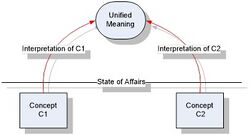Finance:Semantic unification

Semantic unification is the process of unifying lexically different concept representations that are judged to have the same semantic content (i.e., meaning). In business processes, the conceptual semantic unification is defined as "the mapping of two expressions onto an expression in an exchange format which is equivalent to the given expression".[1]
Semantic unification has since been applied to the fields of business processes and workflow management. In the early 1990s Charles Petri[full citation needed] at Stanford University[full citation needed] introduced the term "semantic unification" for business models, later references could be found in[2] and later formalized in Dr. Bendeck's dissertation.[3] Petri introduced the term 'pragmatic semantic unification" to refer to the approaches in which the results are tested against a running application using the semantic mappings.[4] In this pragmatic approach, the accuracy of the mapping is not as important as its usability.
In general, semantic unification as used in business processes is employed to find a common unified concept that matches two lexicalized expressions into the same interpretation.[citation needed]
See also
- Ontology alignment
- Schema Matching
- Semantic mapper
- Semantic integration
- List of language regulators
- Semantic parsing
- Open Mind Common Sense
- Doublespeak
- Disambiguation
References
- ↑ Fawsy Bendeck,Automation of XML Documents Translators Generation. In 10th IEEE, International Workshops on Enabling Technologies: Infrastructure for Collaborative Enterprises, Cambridge, MA, Massachusetts Institute of Technology (MIT), June 2001
- ↑ Yuji Matsumoto, Hozumi Tanaka, Hideki Hirakawa, Hideo Miyoshi, and Hideki Yasukawa, BUP: a bottom-up parser embedded in Prolog. New Generation Computing, 1(2):145-158, 1983.
- ↑ Fawsy Bendeck, WSM-P Workflow Semantic Matching Platform, PhD dissertatation, Business Computer Information System, University of Trier, Germany , 2008.
- ↑ Petrie, C. (2005). "Pragmatic Semantic Unification". IEEE Internet Computing 9 (5): 96–97. doi:10.1109/MIC.2005.107.
- Michael M. Richter, Knowledge Management - Process Modeling, Lecture Notes, Calgary University 2004.
 |
